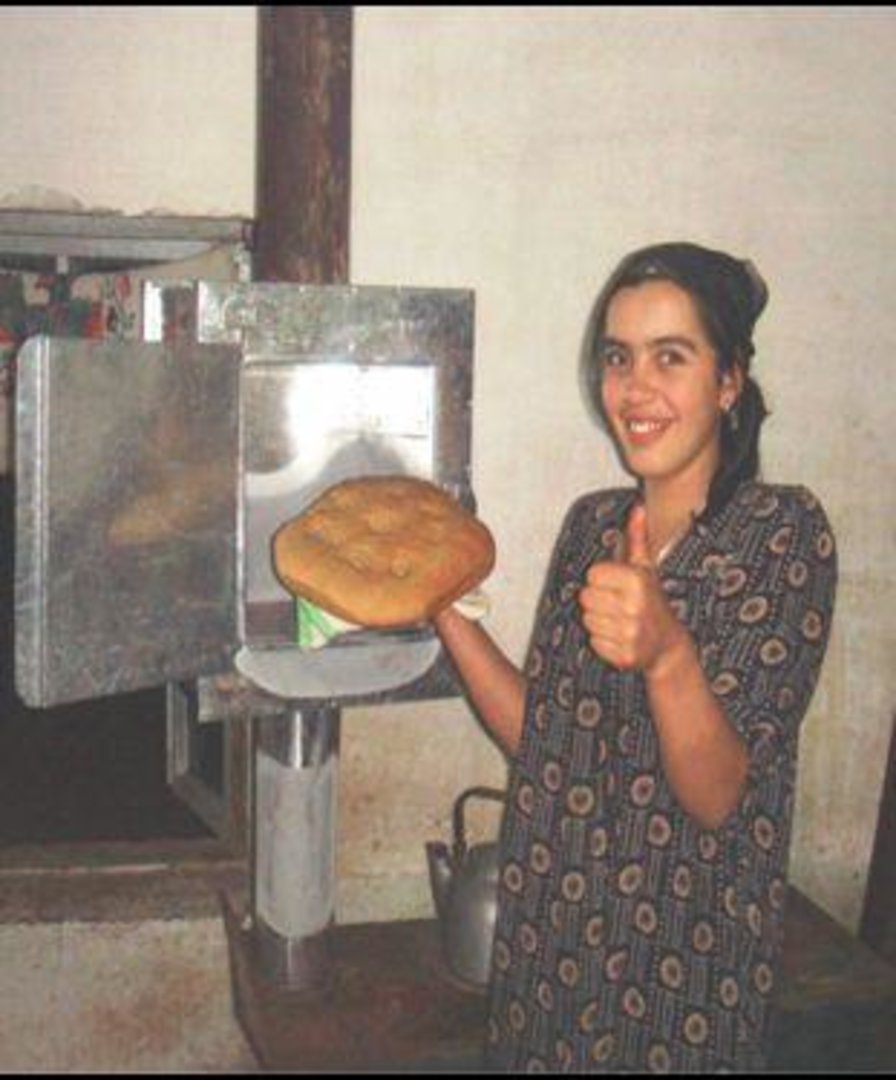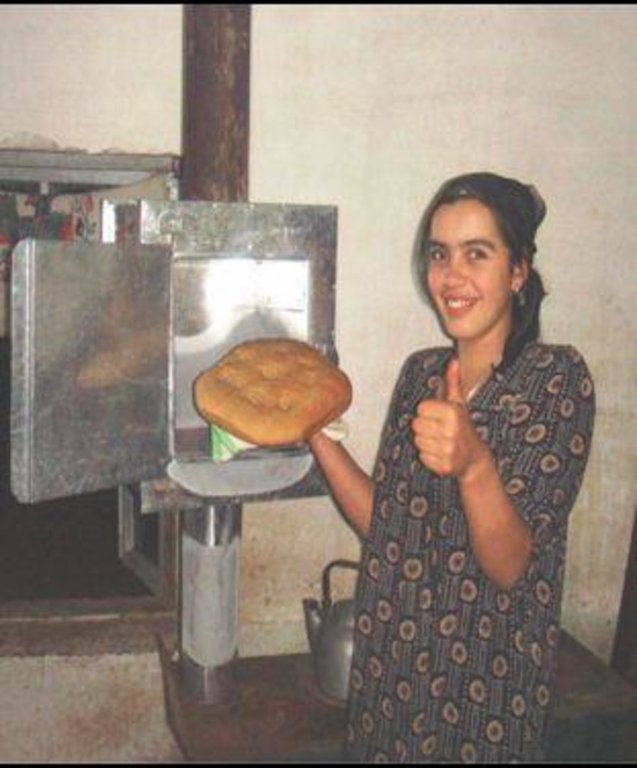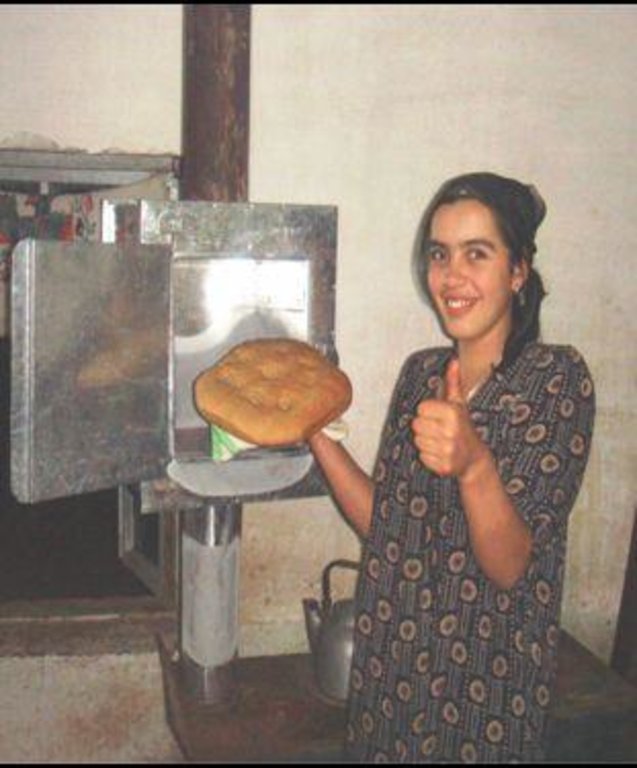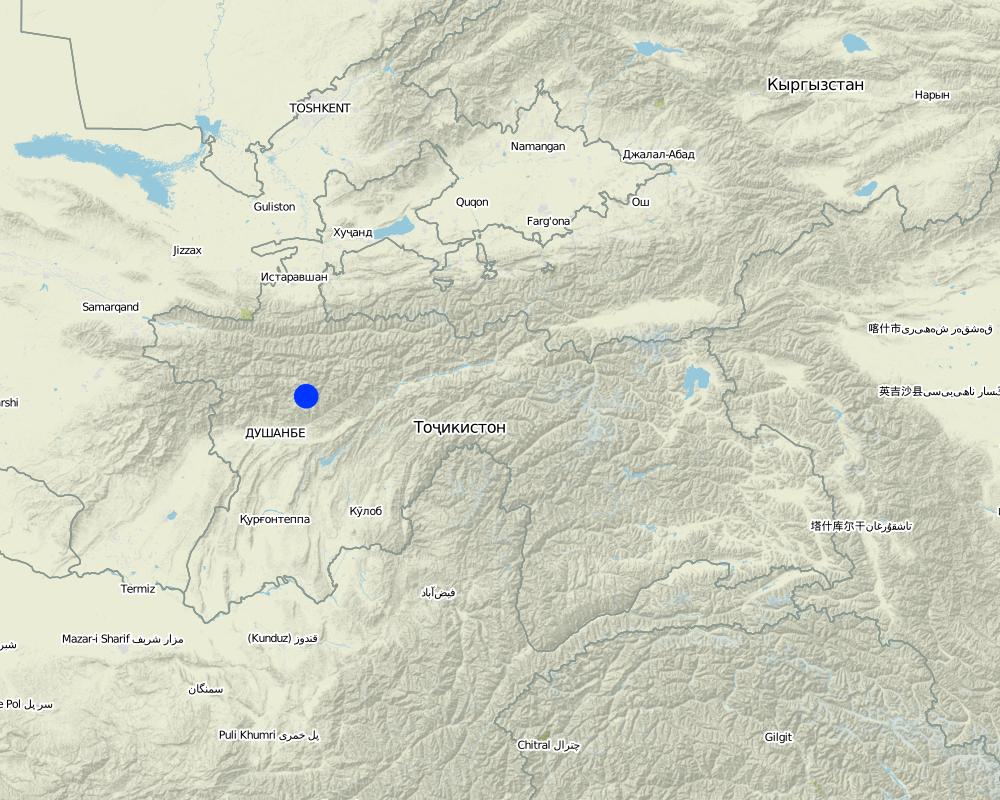Energy efficiency measures to increase the application of organic fertilisers. [Tajiquistão]
- Criação:
- Atualização:
- Compilador/a: Daler Domullojonov
- Editor: –
- Revisores: Laura Ebneter, Alexandra Gavilano, Fabian Ottiger
Бехтар намудани хосилнокии замин ба воситаи амалигардонии чорахои самаранокии истифодабарии неру
technologies_1050 - Tajiquistão
- Resumo completo em PDF
- Resumo completo em PDF para impressão
- Resumo completo no navegador
- Resumo completo (sem formatação)
- Energy efficiency measures to increase the application of organic fertilisers.: 2 de Novembro de 2021 (public)
- Energy efficiency measures to increase the application of organic fertilisers.: 14 de Agosto de 2019 (inactive)
- Energy efficiency measures to increase the application of organic fertilisers.: 21 de Julho de 2017 (inactive)
- Energy efficiency measures to increase the application of organic fertilisers.: 2 de Junho de 2017 (inactive)
- Energy efficiency measures to increase the application of organic fertilisers.: 31 de Maio de 2017 (inactive)
- Energy efficiency measures to increase the application of organic fertilisers.: 27 de Dezembro de 2016 (inactive)
Veja as seções
Expandir tudo Recolher tudo1. Informação geral
1.2 Detalhes do contato das pessoas capacitadas e instituições envolvidas na avaliação e documentação da tecnologia
Pessoa(s) capacitada(s)
Especialista em GST:
Hafizova Tahmina
Welthungerhilfe
Alemanha
Especialista em GST:
Olimov Nazarmad
Welthungerhilfe
Alemanha
Nome da(s) instituição(ões) que facilitou(ram) a documentação/ avaliação da Tecnologia (se relevante)
Deutsche Welthungerhilfe e. V. (Welthungerhilfe) - Tajiquistão1.3 Condições em relação ao uso da informação documentada através de WOCAT
Quando os dados foram compilados (no campo)?
30/04/2011
O/a compilador/a e a(s) pessoa(s) capacitada(s) aceitam as condições relativas ao uso de dados documentados através da WOCAT:
Sim
2. Descrição da tecnologia de GST
2.1 Descrição curta da tecnologia
Definição da tecnologia:
The implementation of several low cost energy efficiency measures to reduce the amount of organic material used as fuel within rural households.
2.2 Descrição detalhada da tecnologia
Descrição:
In many cases local inhabitants of rural areas depend heavily on locally available natural resources, contributing to, and accelerating deforestation. As a low cost fuel source, local households often use cow-dung and wood. Taking these from the local area contributes to decreased soil fertility and erosion processes. Most of the dung collected from livestock is burnt in a very inefficient manner for cooking, baking and heating purposes. Based upon assessments by Welthungerhilfe in 600 households (HH) who were using cow dung as the only fuel material, on average one HH uses 4.6 tons of cow dung annually when using traditional cooking stoves, 6 tons for heating and 4.5 tons for bread baking. This means almost 15.1 tons of cow dung is burnt annually per HH.
Using a simple modification of the traditional cooking stove, approximately 50 - 60% or 2.3 tons of fuel material can be saved. This saving can be further increased by the utilisation of a pressure cooker that decreases the cooking time by 50%. Not all local hot meals can be cooked with a pressure cooker but it can contribute to an additional saving of 0.7 ton of organic matter.
The introduction of a metal heat exchanger on the exhaust pipe of a cast iron stove can help save a household 3 tons of fuel material per year, the effectiveness can be further increased by the incorporation of bread baking compartment.
Further savings can be made by using straw, mud and wood to improve the thermal insulation of the exterior walls, ceiling and floor in the house.
Through the integration of all above measures approx 60% of the current usage rates of organic material used for fuel can be saved. In addition it will keep the house warmer for longer, reduce the smoke in the air, and help retain organic material in the soil.
Purpose of the Technology: The main objective of the energy efficiency technology is to address one of the root causes of the deforestation process and to improve soil fertility i.e. to decrease the demand from the local population for organic fuel. This project used a range of technologies to address this issue which in combination provided substantial savings in organic fuel.
Establishment / maintenance activities and inputs: Cooking stoves: For centuries local populations have been using traditional cooking stoves for cooking, especially during the warm seasons of the year. These were made from a mixture of mud and straw. The modification of these involves improving the aeration process during the burning of the fuel. This is achieved by putting a metallic cover with one inflow cutting and six small smoke outflow holes surrounding the cooking pot. The only input needed which is not locally available is the metallic cover.
Pressure cookers: As maintenance is required 1-2 times per season to keep the cooking stove functioning efficiently, the utilisation of pressure cookers can be easily integrated with the modified cooking stoves.
Heat exchangers: The heat exchangers installed on top of the iron ovens, can be produced by local tradesmen and need to be cleaned every 1-2 months. They have to be installed before the start of the winter season when the heating is needed.
House installation: The house insulation, using locally available materials does not need maintenance once it is installed. However, the storage of dry fruits or bread in the attic should be avoided as it could attract mice which can destroy the insulation.
Welhungerhilfe provided subsidies for all the above work, except for the heat exchangers.
Natural / human environment: The geographical area served by the project is mainly hill slopes, covered in low grade pasture fodder with wheat crops planted in loess soil. Although the soils have the potential to be very fertile, they are overused and not well managed and thus have become degraded and denuded. One of the main contributing factors to this is the removal of organic material from the biomass cycle. Trees, bushes and organic material is cut and collected to be used as fuel.
The main source of income in the area is from semi-subsistence farming, and the removal of organic material has a significant impact on their crops and livestock.
The houses are made from concrete foundations and mud bricks, these and the current stoves are all energy inefficient and fail to retain heat.
2.3 Fotos da tecnologia
2.5 País/região/locais onde a tecnologia foi aplicada e que estão cobertos nesta avaliação
País:
Tajiquistão
Região/Estado/Província:
Tajikistan / Khatlon
Especificação adicional de localização:
Temurmalik . Davad
Map
×2.6 Data da implementação
Caso o ano exato seja desconhecido, indique a data aproximada:
- menos de 10 anos atrás (recentemente)
2.7 Introdução da tecnologia
Especifique como a tecnologia foi introduzida:
- através de projetos/intervenções externas
Comentários (tipos de projeto, etc.):
Promotion of energy efficiency measures began in 2007 by Welthungerhilfe projects
3. Classificação da tecnologia de GST
3.2 Tipo(s) atualizado(s) de uso da terra onde a tecnologia foi aplicada

Assentamentos, infraestrutura
Comentários:
Major land use problems (compiler’s opinion): The land in rural Tajikistan is becomming denuded due to the pressure for organic fertilisers used as a source of fuel for heating and cooking. This impacts on soil quailty, yields and soil stability. This issue is compounded by the relatively high price of mineral fertilisers.
Major land use problems (land users’ perception): Crop yields decrease.
3.3 Mais informações sobre o uso da terra
Número de estações de cultivo por ano:
- 1
Especifique:
Longest growing period in days: 220Longest growing period from month to month: march - october
3.5 Difusão da tecnologia
Especifique a difusão da tecnologia:
- Uniformemente difundida numa área
Caso a tecnologia seja uniformemente difundida numa área, indique a área coberta aproximada:
- > 10.000 km2
Comentários:
Several energy efficiency measures were implemented by households in three neighbouring districts; Baljuvon, Temurmalik and Khovaling. These included the following: cooking stoves were modified in 1,924 HHs (households), pressure cookers were used in 132 HHS, heat exchangers were used in 569 HHs, improved house insulation in 850 HHs, and group bread baking - 10 groups (average of 10 families in each group).
3.6 Medidas de GST contendo a tecnologia

Medidas agronômicas
- A2: Matéria orgânica/fertilidade do solo

Medidas estruturais
- S11: Outros
Comentários:
Main measures: structural measures
3.7 Principais tipos de degradação da terra abordados pela tecnologia

Deteriorização química do solo
- Cn: declínio de fertilidade e teor reduzido de matéria orgânica (não causado pela erosão)

Deteriorização física do solo
- Pc: Compactação
Comentários:
Main type of degradation addressed: Cn: fertility decline and reduced organic matter content
Secondary types of degradation addressed: Pc: compaction
Main causes of degradation: soil management (poor ploughing practices), deforestation / removal of natural vegetation (incl. forest fires) (deforestation), over-exploitation of vegetation for domestic use (removal of trees and bushes for fuel pruposes.), overgrazing (imbalance of carrying capacity and size of livestock herds.), disturbance of water cycle (infiltration / runoff) (reduced infiltration capacity.), poverty / wealth (local population have restricted funds)
Secondary causes of degradation: crop management (annual, perennial, tree/shrub) (monoculture), change of seasonal rainfall (more intensive heavy rainfall events), droughts (events occuring more frequently), population pressure (population is increasing), labour availability (external labour migration)
3.8 Redução, prevenção ou recuperação da degradação do solo
Especifique o objetivo da tecnologia em relação a degradação da terra:
- Prevenir degradação do solo
- Reduzir a degradação do solo
Comentários:
Main goals: prevention of land degradation
Secondary goals: mitigation / reduction of land degradation
4. Especificações técnicas, implementação de atividades, entradas e custos
4.1 Desenho técnico da tecnologia
Autor:
Daler Domullojonov, 14, Giprozem street, app. 27, Dushanbe, Tajikistan
4.2 Especificações técnicas/ explicações do desenho técnico
Heat exchanger adopted by Welthungerhilfe, promoted in communities of the Khatlon region of Tajikistan.
Location: Temurmalik, Baljuvon and Khovaling districts. Khatlon region / Tajikistan
Date: September, 2009
Technical knowledge required for field staff / advisors: high (promotion of EE measures)
Technical knowledge required for land users: moderate (cooking stove modification and use of pressure cookers, mainly by females)
Technical knowledge required for Local masters: high (for construction of heat exchangers and improving house thermal insulation)
Main technical functions: increase in organic matter
Secondary technical functions: improvement of topsoil structure (compaction), increase of infiltration, increase of biomass (quantity)
Structural measure: cook stove
Structural measure: House insulation
Structural measure: Presure cooker
Structural measure: Heat exchanger
4.3 Informação geral em relação ao cálculo de entradas e custos
Outro/moeda nacional (especifique):
TJS
Indique a taxa cambial do dólar norte americano para a moeda local (se relevante): 1 USD =:
4,5
Indique a média salarial da mão-de-obra contratada por dia:
11.00
4.4 Atividades de implantação
| Atividade | Tipo de medida | Periodicidade | |
|---|---|---|---|
| 1. | Cook stove modification | Estrutural | any |
| 2. | Pressure cooker | Estrutural | any |
| 3. | House insulation | Estrutural | once in the beginning |
| 4. | heat exchanger | Estrutural | once in the beginning |
4.5 Custos e entradas necessárias para a implantação
| Especifique a entrada | Unidade | Quantidade | Custos por unidade | Custos totais por entrada | % dos custos arcados pelos usuários da terra | |
|---|---|---|---|---|---|---|
| Mão-de-obra | Labour | per stove | 1,0 | 5,5 | 5,5 | 100,0 |
| Mão-de-obra | Labour | per room | 1,0 | 37,8 | 37,8 | 100,0 |
| Material vegetal | Wheat straw | bales | 12,0 | 4,9 | 58,8 | 100,0 |
| Material de construção | Metallic cover | per stove | 1,0 | 5,1 | 5,1 | 34,0 |
| Material de construção | Earth | per stove | 1,0 | 0,5 | 0,5 | 100,0 |
| Material de construção | Wooden lath | per room | 1,0 | 72,0 | 72,0 | 15,0 |
| Material de construção | Nail, lime, brush, emalen | per room | 1,0 | 30,75 | 30,75 | 100,0 |
| Material de construção | Veneer and glueing silicone | per room | 1,0 | 43,8 | 43,8 | 100,0 |
| Outros | Pressure cooker | piece | 1,0 | 22,2 | 22,2 | 80,0 |
| Outros | heat exchanger | per stove | 1,0 | 30,0 | 30,0 | 100,0 |
| Outros | Transportation cost | 1,0 | 44,0 | 44,0 | 100,0 | |
| Custos totais para a implantação da tecnologia | 350,45 | |||||
Comentários:
Duration of establishment phase: 12 month(s)
4.6 Atividades recorrentes/manutenção
| Atividade | Tipo de medida | Periodicidade/frequência | |
|---|---|---|---|
| 1. | adjustment of modified cook stove | Estrutural | twice per year |
| 2. | cleaning of heat exchanger | Estrutural | twice per year |
4.7 Custos e entradas necessárias pata a manutenção/atividades recorrentes (por ano)
| Especifique a entrada | Unidade | Quantidade | Custos por unidade | Custos totais por entrada | % dos custos arcados pelos usuários da terra | |
|---|---|---|---|---|---|---|
| Mão-de-obra | Labour | per stove | 1,0 | 3,3 | 3,3 | 100,0 |
| Custos totais para a manutenção da tecnologia | 3,3 | |||||
Comentários:
Machinery/ tools: brush
The costs are based upon 2010 prices.
4.8 Fatores mais importantes que afetam os custos
Descreva os fatores mais determinantes que afetam os custos:
The price of the construction materials are dependent on many different external factors, and prices are generally increasing seasonally and annually.
5. Ambiente natural e humano
5.1 Clima
Precipitação pluviométrica anual
- <250 mm
- 251-500 mm
- 501-750 mm
- 751-1.000 mm
- 1.001-1.500 mm
- 1.501-2.000 mm
- 2.001-3.000 mm
- 3.001-4.000 mm
- > 4.000 mm
Zona agroclimática
- Semiárido
Thermal climate class: temperate. 3 months below 5 degrees, 7 months above 10 degrees
5.2 Topografia
Declividade média:
- Plano (0-2%)
- Suave ondulado (3-5%)
- Ondulado (6-10%)
- Moderadamente ondulado (11-15%)
- Forte ondulado (16-30%)
- Montanhoso (31-60%)
- Escarpado (>60%)
Formas de relevo:
- Planalto/planície
- Cumes
- Encosta de serra
- Encosta de morro
- Sopés
- Fundos de vale
Zona de altitude:
- 0-100 m s.n.m.
- 101-500 m s.n.m.
- 501-1.000 m s.n.m.
- 1.001-1.500 m s.n.m.
- 1.501-2.000 m s.n.m.
- 2.001-2.500 m s.n.m.
- 2.501-3.000 m s.n.m.
- 3.001-4.000 m s.n.m.
- > 4.000 m s.n.m.
5.3 Solos
Profundidade do solo em média:
- Muito raso (0-20 cm)
- Raso (21-50 cm)
- Moderadamente profundo (51-80 cm)
- Profundo (81-120 cm)
- Muito profundo (>120 cm)
Textura do solo (solo superficial):
- Médio (limoso, siltoso)
Matéria orgânica do solo superficial:
- Médio (1-3%)
5.4 Disponibilidade e qualidade de água
Lençol freático:
> 50 m
Disponibilidade de água de superfície:
Médio
Qualidade da água (não tratada):
Inutilizável
5.5 Biodiversidade
Comentários e outras especificações sobre biodiversidade:
Species diversity: medium, low
5.6 Características dos usuários da terra que utilizam a tecnologia
Rendimento não agrícola:
- 10-50% de toda renda
Nível relativo de riqueza:
- Muito pobre
- Pobre
Indivíduos ou grupos:
- Indivíduo/unidade familiar
Gênero:
- Mulheres
- Homens
Indique outras características relevantes dos usuários da terra:
Land users applying the Technology are mainly common / average land users
Population density: 10-50 persons/km2
Annual population growth: 1% - 2%
90% of the land users are poor.
10% of the land users are poor.
Off-farm income specification: local inhabitants are in many cases dependent on remittances from Russia and other income generating activities.
5.7 Média da área de terra própria ou arrendada por usuários da terra que utilizam a tecnologia
- < 0,5 ha
- 0,5-1 ha
- 1-2 ha
- 2-5 ha
- 5-15 ha
- 15-50 ha
- 50-100 ha
- 100-500 ha
- 500-1.000 ha
- 1.000-10.000 ha
- > 10.000 ha
É considerado pequena, média ou grande escala (referente ao contexto local)?
- Pequena escala
5.8 Propriedade de terra, direitos de uso da terra e de uso da água
Propriedade da terra:
- Estado
Comentários:
There are a variety of land user and water rights within the three districts, but they do not directly affect the implementation of the technologies.
5.9 Acesso a serviços e infraestrutura
Saúde:
- Pobre
- Moderado
- Bom
Educação:
- Pobre
- Moderado
- Bom
Assistência técnica:
- Pobre
- Moderado
- Bom
Emprego (p. ex. não agrícola):
- Pobre
- Moderado
- Bom
Mercados:
- Pobre
- Moderado
- Bom
Energia:
- Pobre
- Moderado
- Bom
Vias e transporte:
- Pobre
- Moderado
- Bom
Água potável e saneamento:
- Pobre
- Moderado
- Bom
Serviços financeiros:
- Pobre
- Moderado
- Bom
6. Impactos e declarações finais
6.1 Impactos no local mostrados pela tecnologia
Impactos socioeconômicos
Produção
Produção agrícola
Quantidade anterior à GST:
12 t/ha
Quantidade posterior à GST:
21 t/ ha
Risco de falha de produção
Renda e custos
Despesas com insumos agrícolas
Rendimento agrícola
Quantidade anterior à GST:
TJS 100
Quantidade posterior à GST:
TJS 1200
Impactos socioculturais
Segurança alimentar/auto-suficiência
Estado de saúde
Atenuação de conflitos
Impactos ecológicos
Solo
Perda de solo
Compactação do solo
Biodiversidade: vegetação, animais
Biomassa/carbono acima do solo
Outros impactos ecológicos
reduce fuel costs
warmer houses, health benefits
pressure cooker
Comentários/especificar:
Not possible to cook all meals in this
6.3 Exposição e sensibilidade da tecnologia às mudanças climáticas graduais e extremos/desastres relacionados ao clima (conforme o ponto de vista dos usuários da terra)
Mudança climática gradual
Mudança climática gradual
| Estação do ano | Tipo de mudança climática/extremo | Como a tecnologia lida com isso? | |
|---|---|---|---|
| Temperatura anual | aumento | bem |
Extremos (desastres) relacionados ao clima
Desastres meteorológicos
| Como a tecnologia lida com isso? | |
|---|---|
| Temporal local | não conhecido |
| Tempestade de vento local | não conhecido |
Desastres climatológicos
| Como a tecnologia lida com isso? | |
|---|---|
| Seca | bem |
Desastres hidrológicos
| Como a tecnologia lida com isso? | |
|---|---|
| Inundação geral (rio) | não conhecido |
Outras consequências relacionadas ao clima
Outras consequências relacionadas ao clima
| Como a tecnologia lida com isso? | |
|---|---|
| Período de crescimento reduzido | bem |
Comentários:
The thermal could be modified to increase its thermal properties.
6.4 Análise do custo-benefício
Como os benefícios se comparam aos custos de implantação (do ponto de vista dos usuários da terra)?
Retornos a curto prazo:
positivo
Retornos a longo prazo:
muito positivo
Como os benefícios se comparam aos custos recorrentes/de manutenção(do ponto de vista dos usuários da terra)?
Retornos a curto prazo:
muito positivo
Retornos a longo prazo:
muito positivo
Comentários:
As it uses mainly locally available materials, it is a low cost approach which increases energy efficiency and improves resource use.
6.5 Adoção da tecnologia
Comentários:
70% of land user families have adopted the Technology with external material support
1355 land user families have adopted the Technology with external material support
Comments on acceptance with external material support: The amount of the local's contribution to the project themselves was between 52.7% to 100%.
30% of land user families have adopted the Technology without any external material support
569 land user families have adopted the Technology without any external material support
Comments on spontaneous adoption: Fitting heat exchangers, adapting cooking stoves, and improving house thermal insulation are the main forms of technology that have been replicated in the above households.
There is a little trend towards spontaneous adoption of the Technology
Comments on adoption trend: This is restricted due to limited access to funds.
6.7 Pontos fortes/vantagens/oportunidades da tecnologia
| Pontos fortes/vantagens/oportunidades na visão do usuário da terra |
|---|
|
It is very affordable How can they be sustained / enhanced? By involving local relevant authorities and departments |
| It saves and minimises expenditures for electricity, gas, and firewood procurement |
| The rooms are warmer and I can cook bread inside and save more fuel. |
| Pontos fortes/vantagens/oportunidades na visão do/a compilador/a ou de outra pessoa capacitada |
|---|
|
It is a low cost measure using locally available materials. The heat exchanger can improve the heating capacity of the room threefold, for example. How can they be sustained / enhanced? replication rates could be increased through promotion to larger audiences with support of local authorities or by law. |
|
It is environmental friendly and increases the amount of organic material that stays within the soil. How can they be sustained / enhanced? There could be further awareness raising of the benefits of keeping organic materials in the soil. |
| It saves time for collecting fire material wood and cow dung. |
| It presents an opportunity to increase land productivity through application of organic fertilisers |
|
The technologies do not have a large initial financial cost and can be implemented progressively as funds become available. How can they be sustained / enhanced? Training of more local teachers to provide demonstrations to the community. |
6.8 Pontos fracos, desvantagens/riscos da tecnologia e formas de superá-los
| Pontos fracos/desvantagens/riscos na visão do usuário da terra | Como eles podem ser superados? |
|---|---|
| More labour needed to cut fuel into smaller pieces | Behavioural change |
| Pontos fracos/vantagens/riscos na visão do/a compilador/a ou de outra pessoa capacitada | Como eles podem ser superados? |
|---|---|
| Not all meals can be cooked in a pressure cooker | |
| Heat exchangers can get very hot for cooking purposes |
7. Referências e links
7.2 Referências às publicações disponíveis
Título, autor, ano, ISBN:
Brochure "Soil improvement starts with efficient cook stoves! low cost options to increase energy efficiency in Southern Tajikistan"
Disponível de onde? Custos?
Weltgungerhilfe projects in Khatlon region, Temurmalik district
Título, autor, ano, ISBN:
Welthungerhilfe project final narrative report (144-912)
Disponível de onde? Custos?
Weltgungerhilfe projects in Khatlon region, Temurmalik district
Links e módulos
Expandir tudo Recolher tudoLinks
Não há links
Módulos
Não há módulos






